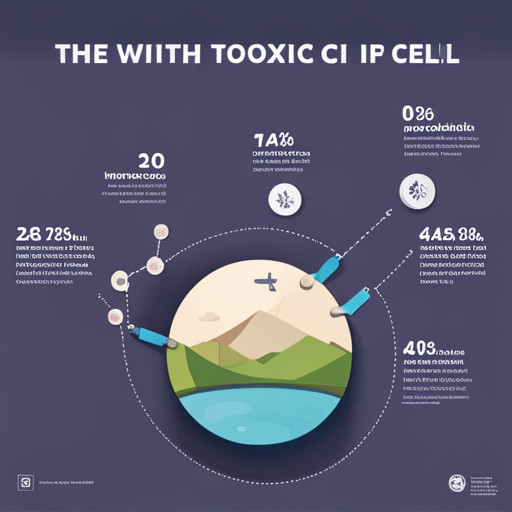From Sink to Cell: The Journey of Toxic Elements
This article explores the journey of toxic elements from initial discharge into the environment to eventual cellular assimilation in humans. It encompasses their sources, pathways, health impacts and mitigative measures.

Furthermore, real-life case studies are presented to underline the pressing relevance of this pervasive public health issue.
Key Takeaways
- Toxic elements can originate from natural geological processes as well as human activities such as mining operations and industrial wastes.
- The release of toxic elements occurs through air emissions, water discharges, and solid waste disposal.
- Inhalation, ingestion, and dermal absorption are the main pathways for the transportation of toxic elements within biological entities.
- Exposure to toxic elements can lead to a range of health implications, including physical and mental conditions, and the risk of developing chronic diseases increases with prolonged exposure.
Understanding Toxic Elements: What They Are and Where They Come From

In order to comprehend the nature and origin of toxic elements, it is essential to examine their physical properties, chemical behaviors, and primary sources. These elements derive from multiple origins including natural geological processes and anthropogenic activities. Their toxicity, as implied by the elemental toxicity classification, varies significantly based on factors such as concentration levels and exposure duration.
Toxic elements encompass a broad range of substances that exhibit harmful effects on living organisms. The elemental toxicity classification categorizes these elements into three groups: non-essential toxic elements (such as lead or mercury), potentially toxic elements (like iron or zinc), and essential trace elements with toxic potential at high concentrations (like copper or selenium). This classification highlights the fact that even necessary micronutrients can induce adverse health impacts under certain conditions.
The sources of these toxic elements are equally diverse, spanning both natural occurrences like volcanic emissions or weathering of rocks, to human-induced activities like mining operations or industrial wastes. Once released into the environment from these various 'toxic element' sources, they may infiltrate water bodies, contaminate soil profiles or become airborne - posing significant public health risks.
Understanding the properties and origins of these toxic entities provides a fundamental basis for further investigations into their biogeochemical cycles and impact on ecological systems. It also underscores the necessity for effective management strategies that mitigate environmental dispersion and human exposure to these hazardous components.
The Pathway of Toxic Elements: How They Travel From Sink to Cell

Understanding the transportation mechanism of hazardous particles from their point of origin to their destination within biological entities constitutes an essential aspect in the field of toxicology. This process, involving 'Toxic Elements' Environmental Impact, Industrial Emission Control', and other variables, offers insight into how pollutants affect organisms and their environments.
The journey of toxic elements begins with release or emission from industrial or natural sources. Primary modes include air emissions, water discharges, and solid waste disposal. These elements then enter environmental media such as air, water and soil through various physical processes like diffusion or advection.
Depending on their chemical properties and environmental conditions, these elements undergo transformations that can alter their mobility and toxicity. For instance, mercury emitted from coal-fired power plants can be converted into highly toxic methylmercury in aquatic systems.
Transportation within biological entities occurs via several pathways. Inhalation is a primary route for airborne toxins whereas ingestion is the main pathway for contaminants present in food or water; dermal absorption also plays a role for certain substances.
Once inside an organism, these particles move across physiological barriers such as cell membranes through passive diffusion or active transport mechanisms depending upon their size, shape and solubility. Within cells they may interact with macromolecules causing adverse effects ranging from oxidative stress to DNA damage.
Industrial emission control strategies are crucial to limit the release of these hazardous particles into the environment thus reducing 'Toxic Elements' Environmental Impact'. Such strategies involve pollution prevention techniques like cleaner production processes along with end-of-pipe treatment solutions like filtration systems which capture pollutants before they are released.
The Impact of Toxic Elements on Human Health

Exposure to hazardous particles can elicit a myriad of health implications in humans, ranging from minor irritations to severe chronic diseases. Toxicity symptoms often serve as visible indicators of such adverse effects, manifesting in an array of physical and mental conditions.
Element bioaccumulation, the gradual concentration increase of toxic elements within an organism's body over time, is a significant contributor to these detrimental health outcomes.
An analytical examination reveals that bioaccumulation primarily results from constant exposure to low doses of toxic elements present in the environment. The persistence of these toxins allows for their continuous absorption and storage in biological tissues. Over time, this accumulation may surpass the body's detoxification capacities leading to toxicity symptoms.
Technical data substantiates the correlation between element bioaccumulation and toxicity symptoms. Certain toxic elements target specific organs or systems within the human body; lead for instance tends to accumulate in bones and teeth affecting their structure and function while mercury predominantly targets neuronal tissues inducing neurotoxic effects.
Further studies suggest that prolonged exposure increases not only toxicity but also risk for developing chronic diseases such as neurological disorders, cardiovascular disease, and various forms of cancer.
Strategies for Mitigating Exposure to Toxic Elements

Mitigation strategies against harmful substances in the environment include protective measures, remediation techniques, and policy interventions to reduce human contact with these risks.
The adoption of green alternatives represents a significant mitigation strategy. Green alternatives refer to sustainable practices that significantly decrease environmental pollutants while preserving resources for future generations. These may include the use of renewable energy sources, organic farming methods, and eco-friendly products.
At the household level, precautions can be undertaken to mitigate exposure to toxic elements. Household precautions range from simple actions such as proper waste disposal and regular cleaning practices to more complex measures such as installing water purification systems and using air purifiers to reduce indoor air pollution.
Remediation techniques are another aspect of mitigation strategies that involve eliminating or reducing the presence of harmful substances after contamination has occurred. This might include soil decontamination processes or wastewater treatment facilities.
Policy interventions also play a critical role in mitigating exposure by enforcing regulations on industrial emissions, banning hazardous substances, and promoting public awareness about potential environmental hazards. Government bodies should continue implementing stringent regulations regarding chemical usage and disposal while encouraging companies' transition towards greener production methods.
Case Studies: Real Life Examples of Toxic Elements Journey From Sink to Cell

Several case studies provide insight into the complex pathways harmful substances traverse from their source to eventual cellular uptake, highlighting the real-life implications of these processes. These investigations offer an opportunity for analyzing contamination sources and examining remediation techniques in practical contexts.
In environmental biochemistry, a significant focus is often placed on heavy metal pollution. One case study from Flint, Michigan, presented a severe example of lead contamination in drinking water due to corrosion of aging pipes. The lead particles journeyed from the water supply infrastructure directly into households, subsequently being ingested and absorbed by residents at the cellular level causing widespread health issues.
Another investigation took place after a mercury spill in Minamata, Japan. Industrial waste was released into the local environment, with methylmercury making its way up through aquatic food chains until it reached human consumers. This phenomenon underscored how toxins can travel long distances before reaching vulnerable populations.
Remediation techniques are crucial for mitigating such situations and reinstating safe environments. In Flint's case, pipe replacement programs were initiated alongside water treatment improvements. Meanwhile, Minamata implemented stringent regulations for industrial waste disposal and promoted detoxification efforts among affected communities.
These examples demonstrate that understanding contaminants' routes from sink to cell is vital for effective mitigation strategies. It underlines that not only should sources of contamination be thoroughly analyzed but also robust remediation techniques must be put in place to prevent or limit exposure to toxic elements.
Frequently Asked Questions
What Are the Common Symptoms of Exposure to Toxic Elements?
Exposure to toxic elements often manifests as nausea, headaches, and skin irritations. Through Toxic Elements Detection techniques and implementing Preventive Measures, these adverse health effects can be mitigated or potentially avoided altogether.
Are There Any Specific Age Groups That Are More Susceptible to the Harmful Effects of Toxic Elements?
Age-specific detoxification capabilities are not uniformly developed, rendering certain age groups more vulnerable to toxic elements. Particularly, children's vulnerability is heightened due to their developing physiological and metabolic systems being less efficient at detoxification.
How Can the Movement of Toxic Elements in the Environment Be Tracked?
The movement of toxic elements can be tracked using sophisticated techniques, such as Toxic Element Detection and Environmental Pollution Measures. These methodologies involve analyzing samples from various environmental sources to detect and quantify the presence of toxins.
Are There Any Successful Examples of Communities or Regions Significantly Reducing Their Exposure to Toxic Elements?
Yes, numerous instances exist where regions have significantly reduced toxic element exposure via preventive measures implementation and contaminant filtering techniques. Such methods have successfully mitigated environmental contamination, enhancing public health outcomes.
Can the Damage Caused by Toxic Elements Be Reversed, and if So, How?
Damage caused by toxic elements can be potentially reversed through detoxification methods which include chelation therapy, dietary changes, and avoidance of exposure for toxicity prevention, albeit depending on the severity and duration of exposure.
Conclusion
In conclusion, the journey of toxic elements from sink to cell is a complex process with significant implications for human health. Understanding their path and influence aids in developing strategies to mitigate exposure.
Through real-life examples, the grave consequences of these hazardous elements are highlighted, emphasizing the urgent need for effective countermeasures. Further research is essential to refine these strategies and better protect public health.

This post has been generated by AI and was not reviewed by editors. This is Not legal advice. Please consult with an attorney.




